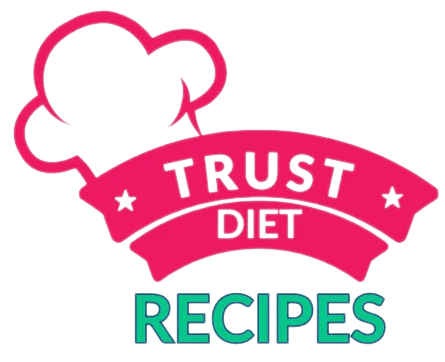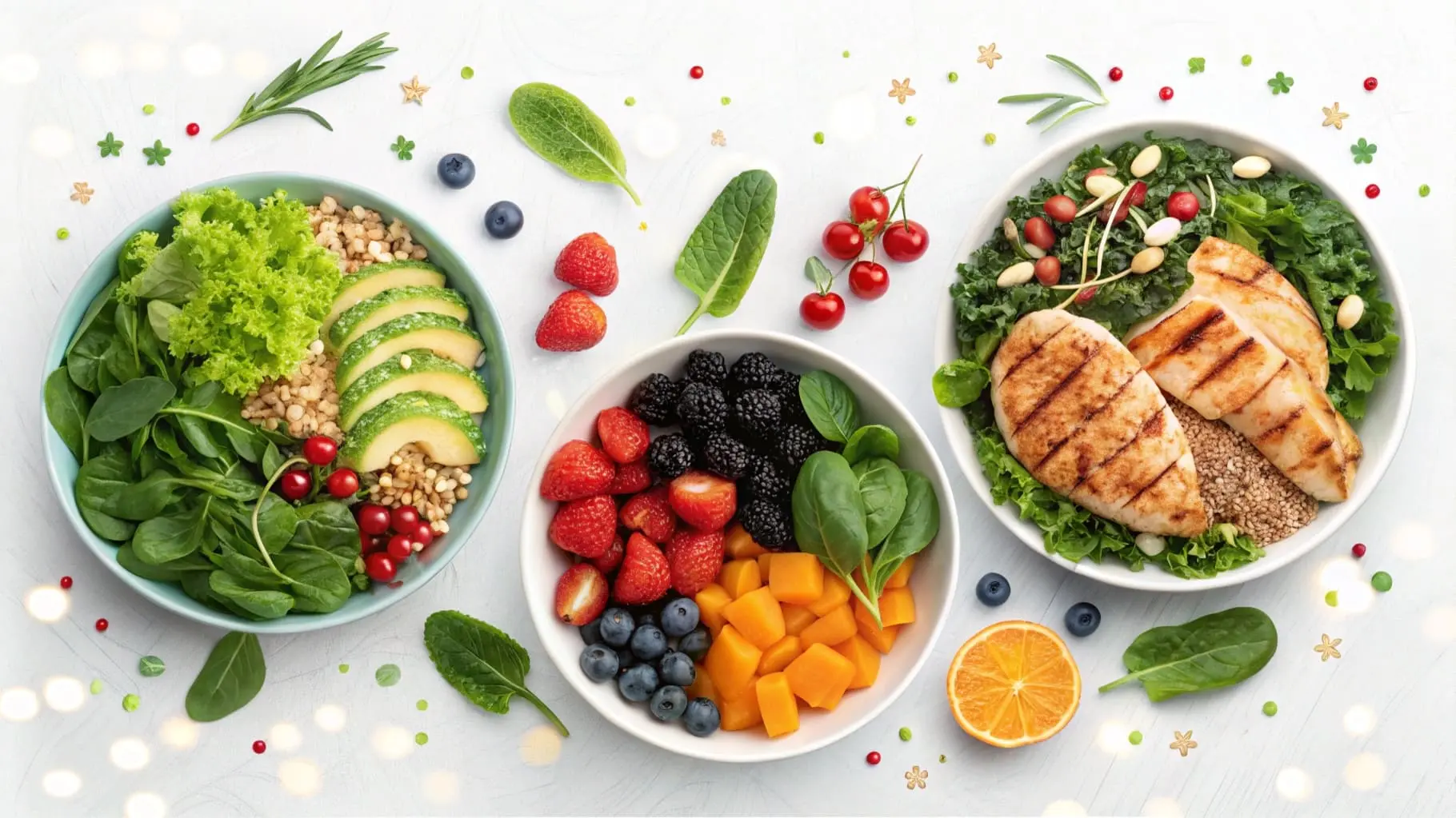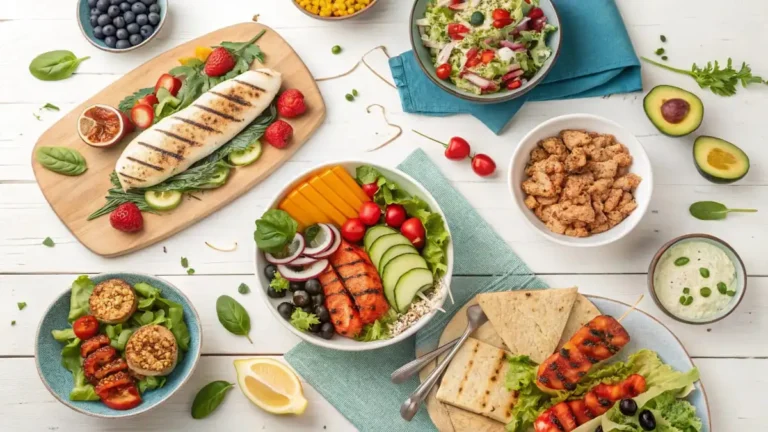The Gluten Free Diet Explained: Benefits, Challenges & Myths Debunked
you’ve probably heard a lot about the gluten free diet lately. Maybe your favorite celebrity is on it, or you’ve seen countless gluten-free products popping up in grocery stores. It’s become more than just a diet – it’s almost a lifestyle. But what is a gluten-free diet really about? Is it just a fad, or are there real reasons why people choose to cut out gluten? And is it healthier for everyone?
This isn’t just a simple “eat this, not that” kind of guide. We’re going to dive deep into the science behind gluten and why it can be a problem for some people. We’ll explore the real benefits of a gluten free diet, but also the challenges it brings. And we’ll bust some common myths that you might have heard about going gluten-free. Think of this as your complete guide to understanding the gluten-free world, so you can make smart choices for your health and well-being.
Table of Contents
I. Understanding Gluten and its Impact: What Exactly IS Gluten Anyway?
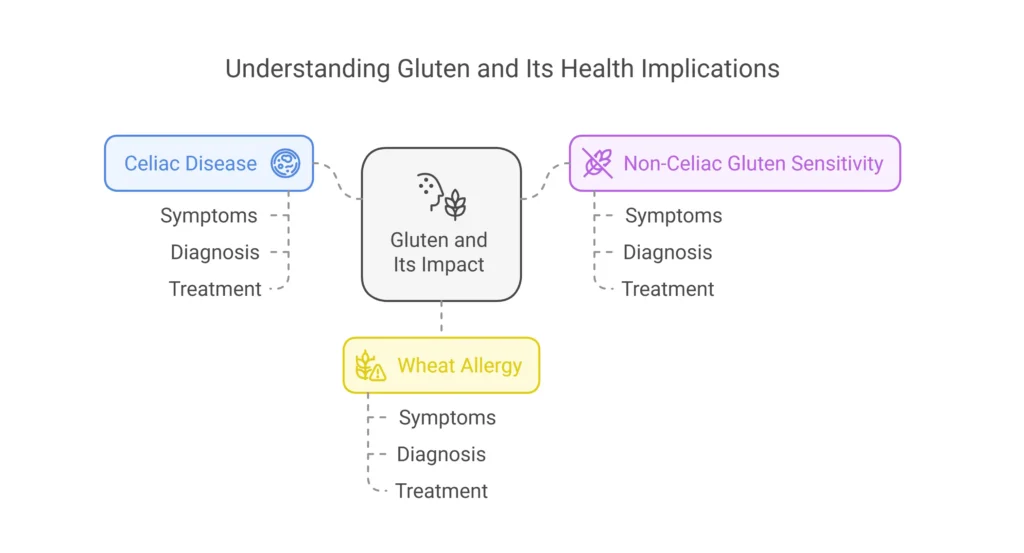
Let’s start with the basics: what is gluten? Imagine gluten as the “glue” in certain grains. It’s a mix of proteins, and it’s naturally found in wheat, barley, and rye. Think about bread dough – it’s stretchy and elastic, right? That’s gluten at work! It gives baked goods their chewy texture and helps them rise.
For most people, gluten is harmless. Your body can digest it just fine. But for some individuals, gluten can cause real problems. It’s not just a matter of “sensitivity” in all cases – there are different medical conditions where gluten plays a major role. Let’s break down the main ones:
A. Celiac Disease: When Gluten Attacks Your Gut
Celiac disease is a serious autoimmune disorder. Think of your immune system as your body’s defense force, protecting you from germs and bad stuff. But in celiac disease, your immune system gets confused and mistakenly sees gluten as a threat. When someone with celiac disease eats gluten, their immune system attacks the lining of their small intestine.
The small intestine is super important because it’s where your body absorbs nutrients from food. Imagine the lining of your small intestine like a carpet with tiny little bumps called villi. These villi increase the surface area, helping you absorb all the good stuff from your food. But in celiac disease, the immune attack damages and flattens these villi. This damage makes it much harder for your body to absorb vitamins, minerals, and other essential nutrients.
Symptoms of Celiac Disease: The symptoms of celiac disease can be all over the place and vary from person to person. Some people have obvious gastrointestinal issues, like:
- Diarrhea: Loose, watery stools.
- Bloating: Feeling full and swollen in your belly.
- Abdominal Pain: Stomach aches and cramps.
But celiac disease can also cause symptoms that don’t seem related to your gut at all, such as:
- Fatigue: Feeling tired all the time, even after sleeping.
- Anemia: Low iron levels in your blood, leading to weakness and fatigue.
- Skin Rashes: Itchy, blistering skin conditions like dermatitis herpetiformis.
- Weight Loss: Unexplained weight loss due to poor nutrient absorption.
- Bone Pain: Due to vitamin D and calcium malabsorption.
- Nerve Problems: Numbness or tingling in hands and feet.
- Mouth Ulcers: Sores in the mouth.
Diagnosing Celiac Disease: If doctors suspect celiac disease, they’ll usually start with blood tests. These tests look for specific antibodies in your blood that are often elevated in people with celiac disease. If the blood tests suggest celiac, the next step is usually an endoscopy with a biopsy. This is a procedure where a thin, flexible tube with a camera is inserted down your throat into your small intestine. The doctor takes a small tissue sample (biopsy) to examine under a microscope for damage to the villi.
Treatment for Celiac Disease: Sadly, there’s no cure for celiac disease. The only treatment is a lifelong adherence to a strict gluten-free diet. This means completely avoiding all foods and drinks that contain wheat, barley, and rye. Even tiny amounts of gluten can trigger an immune reaction and damage the small intestine in someone with celiac disease.
B. Non-Celiac Gluten Sensitivity (NCGS): Gluten Sensitivity Without Gut Damage
Non-celiac gluten sensitivity (NCGS) is a condition where people experience symptoms similar to celiac disease after eating gluten but without the intestinal damage seen in celiac. It’s also sometimes called gluten intolerance, but it’s not the same as a wheat allergy (we’ll get to that next).
Symptoms of NCGS: The symptoms of NCGS can overlap with celiac disease, making it tricky to tell the difference. People with NCGS often report:
- Digestive Issues: Bloating, abdominal pain, diarrhea, constipation.
- Fatigue: Feeling tired and drained.
- Headaches: Frequent headaches.
- “Brain Fog”: Difficulty concentrating, feeling mentally cloudy.
- Joint Pain: Aches and stiffness in joints.
Diagnosing NCGS: Diagnosing NCGS is challenging because there’s no specific test for it like there is for celiac disease. Blood tests and endoscopies will come back negative for celiac in someone with NCGS. Instead, NCGS is often diagnosed through a process of elimination. Doctors might recommend an elimination diet, where you remove gluten from your diet for some time and see if your symptoms improve. If you feel better without gluten, and your celiac tests are negative, NCGS might be the diagnosis. Symptom monitoring is also key – tracking how you feel when you eat gluten and when you avoid it.
Mechanism of NCGS: Scientists are still working to understand exactly how NCGS works. Unlike celiac disease, it doesn’t seem to be an autoimmune reaction. The exact mechanism is unknown, but it’s thought that gluten, or other components of wheat, might trigger inflammation and digestive discomfort in the gut of sensitive individuals. It’s also possible that other substances in wheat, besides gluten, like FODMAPs (certain types of carbohydrates), might be contributing to the symptoms.
Treatment for NCGS: The main treatment for NCGS is, again, a gluten free diet. However, it might not need to be as strictly enforced as for celiac disease. Some people with NCGS can tolerate small amounts of gluten without symptoms, while others need to be very careful. It’s often about finding your tolerance level. Working with a doctor or dietitian can help you figure out the best approach for managing your symptoms with NCGS.
C. Wheat Allergy: A True Allergy to Wheat Proteins
Wheat allergy is different from both celiac disease and NCGS. It’s a true allergic reaction to wheat proteins, which can include gluten, but also other proteins found in wheat. It’s similar to other food allergies, like peanut or milk allergies. When someone with a wheat allergy eats wheat, their immune system reacts immediately.
Symptoms of Wheat Allergy: Wheat allergy symptoms are usually immediate and can be quite severe. They can include:
- Hives: Itchy, raised welts on the skin.
- Swelling: Swelling of the lips, tongue, face, or throat.
- Itching: Itching in the mouth or throat.
- Nausea and Vomiting: Feeling sick to your stomach and throwing up.
- Diarrhea: Loose stools.
- Difficulty Breathing: Wheezing, coughing, shortness of breath (in severe cases, anaphylaxis, a life-threatening allergic reaction).
Diagnosing Wheat Allergy: Wheat allergy is diagnosed through allergy testing, which can include:
- Skin Prick Test: A small amount of wheat extract is pricked onto the skin to see if there’s a reaction.
- Blood Test: Measures specific IgE antibodies in the blood related to wheat allergy.
- Oral Food Challenge: In some cases, under medical supervision, a small amount of wheat is given to see if a reaction occurs.
Treatment for Wheat Allergy: The main treatment for wheat allergy is strict avoidance of wheat and foods containing wheat. People with wheat allergy also need to be prepared to manage accidental reactions. They often carry an epinephrine auto-injector (EpiPen) to use in case of a severe allergic reaction like anaphylaxis. It’s crucial to seek immediate medical attention if you suspect a wheat allergy reaction.
Key Differences Summarized:
To keep it clear, here’s a quick summary of the key differences between these three conditions:
| Condition | Cause | Intestinal Damage | Allergy Test | Gluten-Free Diet | Wheat Avoidance | Medical Emergency (Reaction) |
| Celiac Disease | Autoimmune to gluten | Yes | Negative | Strict, Lifelong | Yes | No |
| NCGS | Unknown, ?gluten/wheat | No | Negative | May be less strict | May be less strict | No |
| Wheat Allergy | True allergy to wheat pro. | No | Positive | Yes | Strict, Always | Yes (Anaphylaxis) |
II. Benefits of a Gluten Free Diet: When is it Helpful?
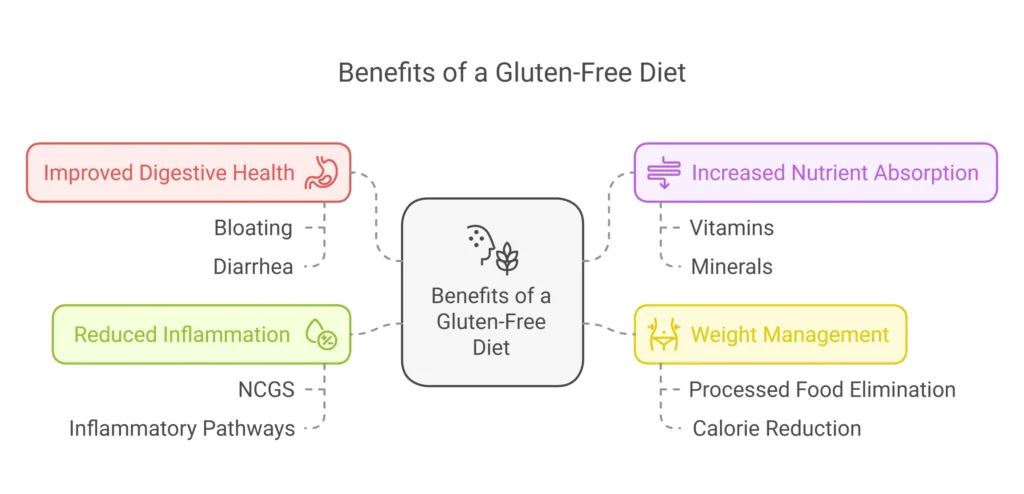
Now that we understand the different conditions, let’s talk about the benefits of a gluten free diet. It’s crucial to remember that a gluten free diet is medically necessary for people with celiac disease and wheat allergy. For them, it’s not a choice – it’s essential for their health and well-being. For people with NCGS, it can also significantly improve their quality of life by reducing uncomfortable symptoms.
Potential Benefits (When Medically Indicated and Managed Properly):
When a gluten-free diet is medically indicated (meaning you have celiac disease, wheat allergy, or NCGS diagnosed by a doctor) and managed properly (meaning you’re eating a balanced diet, not just processed gluten-free junk food), there can be real benefits:
- Improved Digestive Health: For people with celiac disease and NCGS, eliminating gluten can drastically reduce uncomfortable digestive symptoms like bloating, gas, diarrhea, and abdominal pain. When the small intestine in celiac disease starts to heal on a gluten-free diet, digestive function improves significantly.
- Increased Nutrient Absorption: In celiac disease, the damaged intestinal lining prevents proper nutrient absorption. A gluten-free diet allows the intestinal lining to heal, and as the villi recover, the body becomes much better at absorbing essential vitamins and minerals from food. This can help reverse nutrient deficiencies like anemia and vitamin D deficiency.
- Weight Management (In Some Cases): It’s not a guaranteed weight loss diet, but some individuals find that a gluten free diet aids weight loss. This might be because when people go gluten-free, they often eliminate a lot of processed foods that are high in calories, unhealthy fats, and sugar, and often contain gluten (like many baked goods, fast food, and processed snacks). If you replace those with whole, unprocessed gluten-free foods, you might naturally reduce your calorie intake and lose weight. However, it’s also possible to gain weight on a gluten-free diet if you replace gluten-containing foods with high-calorie, low-nutrient gluten-free processed foods.
- Reduced Inflammation (For Some with NCGS): For people with NCGS, eliminating gluten may help reduce systemic inflammation in the body. Inflammation is linked to many health problems. While the exact mechanism of NCGS isn’t fully understood, it’s thought that gluten might trigger inflammatory pathways in sensitive individuals. Reducing gluten might therefore reduce overall inflammation and improve symptoms beyond just digestive issues. However, more research is still needed in this area.
Important Note: These benefits are not guaranteed for everyone, and they primarily apply to people who have a medical reason to be gluten-free. For people without celiac disease, wheat allergy, or NCGS, there’s no solid scientific evidence that a gluten-free diet offers any general health benefits.
III. Challenges of a Gluten Free Diet: It’s Not Always Easy!
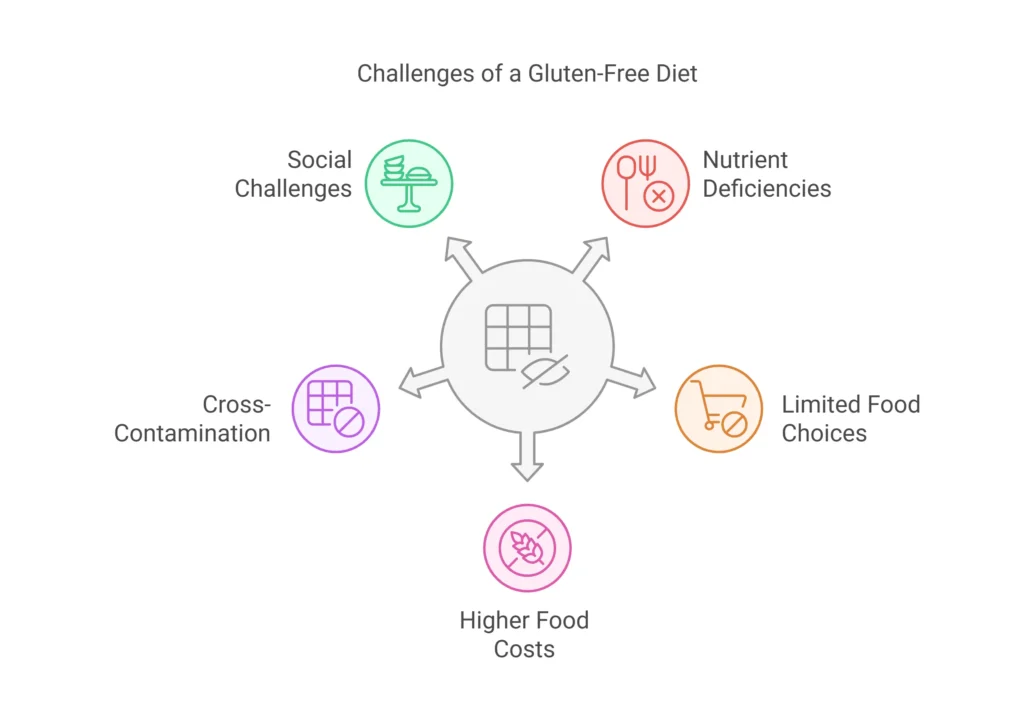
While a gluten-free diet can be life-changing for those who need it, it’s important to be realistic – it also comes with challenges. It’s not always easy to maintain a balanced and healthy gluten-free lifestyle. Let’s look at some of the common hurdles:
- Nutrient Deficiencies: Whole grains like wheat, barley, and rye are good sources of important nutrients, including iron, fiber, and B vitamins. When you eliminate these grains, you risk missing out on these nutrients. Many gluten free alternatives, especially processed ones, are often made with refined flours (like white rice flour or tapioca starch) that are lower in these nutrients than whole wheat. It’s crucial to carefully plan your gluten-free diet to ensure you’re getting enough of these essential nutrients. Careful planning and supplementation are often necessary to avoid deficiencies.
- Limited Food Choices: Gluten is surprisingly common in many foods, not just obvious ones like bread and pasta. It’s used as a thickener, stabilizer, and ingredient in sauces, dressings, processed meats, and even some medications! Many restaurants and packaged foods contain gluten, making eating out and grocery shopping more complicated. You need to be a careful label reader and ask lots of questions when dining out. This requires careful meal planning and can feel restrictive at times.
- Higher Food Costs: Unfortunately, gluten-free products tend to be more expensive than their gluten-containing counterparts. Gluten-free bread, pasta, crackers, and baked goods often cost significantly more. This can add up, especially if you’re relying heavily on processed gluten-free replacements. While naturally gluten-free whole foods like rice, quinoa, fruits, and vegetables are affordable, building a gluten-free pantry can be financially challenging for some.
- Cross-Contamination: Even if you’re diligent about choosing gluten-free foods, accidental exposure to gluten through cross-contamination is a real risk. This can happen in food preparation if gluten-free foods are prepared on surfaces or with utensils that have been used for gluten-containing foods. It can also happen in shared cooking spaces, like toasters or fryers. For someone with celiac disease, even a tiny amount of cross-contamination can trigger symptoms. You need to be extra careful about food handling and preparation to minimize this risk.
- Social Challenges: Dining out and attending social events can be more challenging on a gluten-free diet. You need to plan, research restaurants, and communicate your dietary needs to hosts and servers. Sometimes, gluten-free options are limited or not available at all. It can feel isolating or awkward to always be the “special needs” eater. Social situations that revolve around food can become more stressful and require extra effort.
IV. Misconceptions About Gluten Free Diets: Separating Fact from Fiction
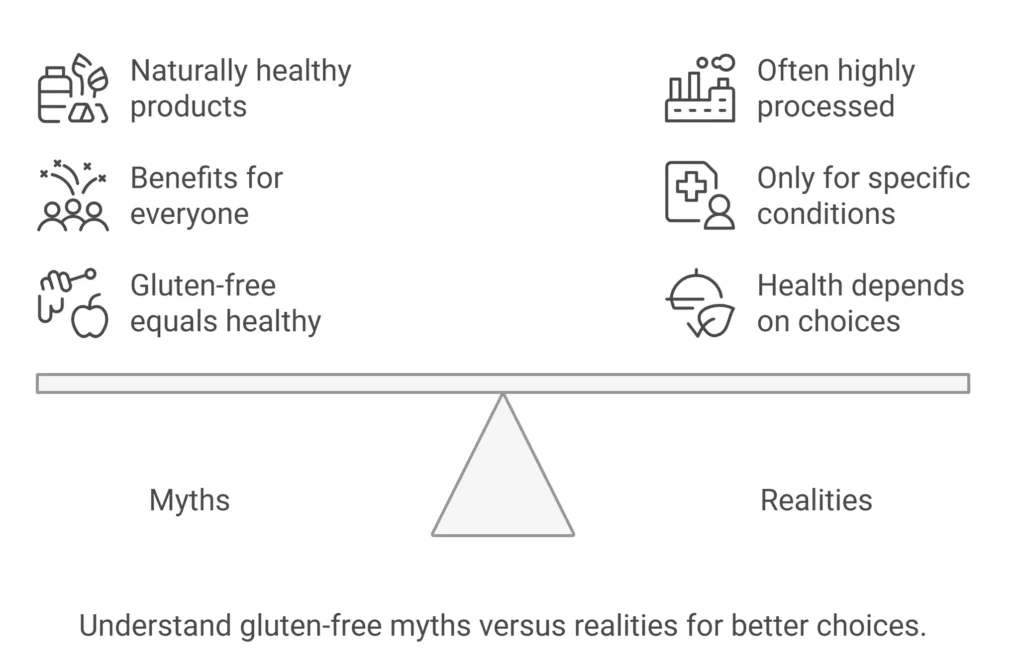
With the rise in popularity of gluten-free diets, a lot of misinformation has also spread. It’s important to separate fact from fiction and understand what’s true about gluten-free eating. Let’s bust some common myths:
- Myth: A gluten free diet is automatically healthier.
Reality: This is a big myth! Just because something is labeled “gluten-free” doesn’t automatically make it healthy. Many gluten-free processed foods are high in sugar, fat, and calories, and low in nutrients. Think of gluten-free cookies, cakes, chips, and processed snacks – they can be just as unhealthy (or even more so) than their gluten-containing counterparts. A truly healthy gluten-free diet focuses on whole, unprocessed foods like fruits, vegetables, lean proteins, and naturally gluten-free grains like quinoa and brown rice, not just gluten-free junk food.
- Myth: Everyone benefits from a gluten free diet.
Reality: This is not true. A gluten-free diet is medically necessary only for those with celiac disease, wheat allergy, or NCGS. For people without these conditions, there’s no scientific evidence that it offers any general health benefits. In fact, for some people, unnecessarily restricting gluten might even be detrimental, potentially leading to nutrient deficiencies and making social situations more difficult. Unless you have a medical reason to be gluten-free, there’s no need to cut out gluten.
- Myth: Gluten-free products are always naturally healthy.
Reality: We’ve touched on this already, but it’s worth repeating. Many gluten-free products are highly processed and can be low in nutritional value. Just like regular processed foods, gluten-free versions can be loaded with refined flour, added sugars, unhealthy fats, and artificial ingredients. Don’t assume that “gluten-free” on a label means “healthy.” Always read the nutrition facts and ingredient list to make informed choices, even when buying gluten-free products. Focus on whole, naturally gluten-free foods instead of relying solely on processed replacements.
V. Gluten Free Alternatives and Food Labeling: What CAN You Eat?
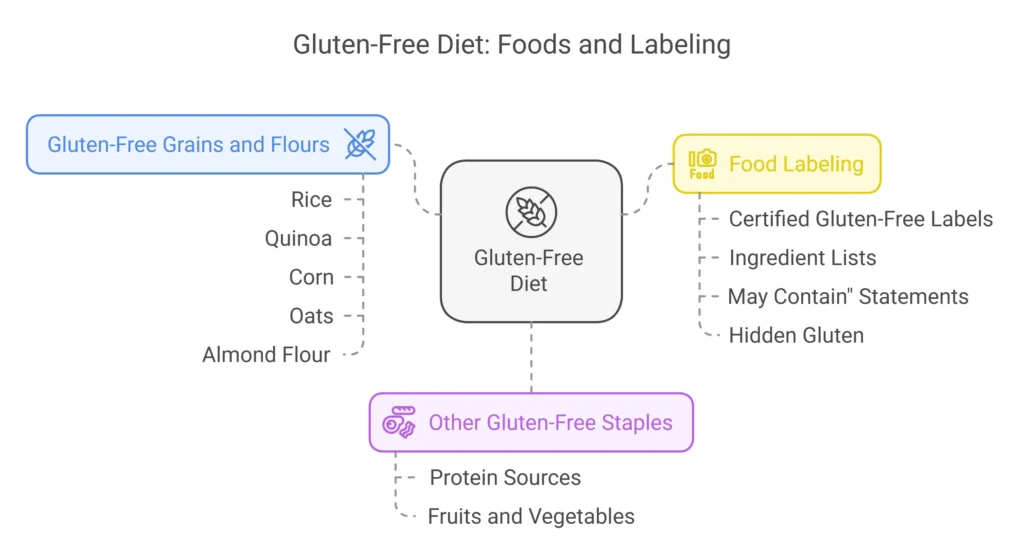
Okay, so what can you eat on a gluten-free diet? The good news is, there are plenty of delicious and nutritious gluten-free alternatives available! It’s about shifting your focus to naturally gluten-free foods and choosing smart replacements for gluten-containing ones.
Gluten-Free Grains and Flours:
- Grains: You can enjoy grains on a gluten-free diet! Great options include:
- Rice: All types of rice (white, brown, basmati, jasmine, wild rice) are naturally gluten-free.
- Quinoa: A protein-rich seed that’s often used like a grain.
- Corn: Cornmeal, polenta, and popcorn are gluten-free (but be careful with corn products that might have wheat added, like some tortillas).
- Amaranth: An ancient grain with a slightly nutty flavor.
- Oats (Carefully Sourced and Certified Gluten Free): Oats themselves are naturally gluten-free, but they are often processed in facilities that also handle wheat, leading to cross-contamination. Look for oats that are certified gluten free to ensure they are safe.
- Flours: There’s a wide world of gluten-free flours to explore for baking and cooking:
- Rice Flour: Made from ground rice, can be white or brown rice flour.
- Almond Flour: Made from ground almonds, adds a slightly nutty flavor and moisture.
- Coconut Flour: Made from dried coconut, very absorbent and slightly sweet.
- Tapioca Flour (or Starch): Made from the cassava root, used for thickening and texture.
- Potato Starch: Similar to tapioca starch, used for thickening.
Other Gluten-Free Staples:
- Protein Sources: Naturally gluten-free protein sources are abundant:
- Lentils, Beans, Chickpeas: Legumes are packed with protein and fiber.
- Meat, Fish, Poultry: Fresh, unprocessed meat, fish, and poultry are gluten-free (but be careful with processed or breaded versions).
- Eggs: Versatile and protein-rich.
- Fruits and Vegetables: All fruits and vegetables are naturally gluten-free! Load up on them!
Food Labeling: Be a Label Detective!
Food labeling is crucial when you’re on a gluten-free diet. You need to become a diligent label reader. Here’s what to look for:
- “Certified Gluten-Free” Labels: In many countries, including the US and Europe, there are regulations for “gluten-free” labeling. This usually means the product contains less than 20 parts per million (ppm) of gluten. Look for certified gluten-free labels from reputable organizations – this gives you extra assurance.
- Ingredient Lists: Read ingredient lists carefully. Avoid ingredients that contain wheat, barley, or rye. Look out for words like:
- Wheat (all types: durum, semolina, spelt, kamut, farro, etc.)
- Barley
- Rye
- Malt (often made from barley)
- Brewer’s Yeast (can be grown on barley)
- Oats (unless certified gluten-free)
- “May Contain” Statements: Pay close attention to “may contain” or “made in a facility that also processes wheat” statements. These indicate potential cross-contamination risks. If you have celiac disease or are very sensitive, you may need to avoid products with these warnings.
- Hidden Gluten: Be aware of hidden gluten sources in unexpected places, such as:
- Soy sauce (most traditional soy sauces contain wheat)
- Salad dressings
- Sauces and gravies
- Processed meats (like sausages and deli meats)
- Soups (especially cream-based soups)
- Some candies and chocolates
- Medications and supplements (check with your pharmacist)
VI. Maintaining a Balanced Gluten Free Diet: Eating Healthy AND Gluten-Free
It’s possible to eat a healthy and balanced diet while being gluten-free! The key is to focus on whole, naturally gluten-free foods and be mindful of nutrient intake. Here are some tips for maintaining a balanced gluten free diet:
- Focus on Whole Foods: Base your diet around whole, unprocessed foods that are naturally gluten-free. Think:
- Plenty of Fruits and Vegetables: Aim for a rainbow of colors!
- Lean Proteins: Chicken, fish, beans, lentils, eggs.
- Healthy Fats: Avocado, nuts, seeds, olive oil.
- Naturally Gluten-Free Grains: Quinoa, brown rice, oats (certified gluten-free).
- Careful Planning: Plan your meals and snacks to ensure you’re getting a variety of nutrients. Don’t just rely on pre-packaged gluten-free foods. Cook from scratch more often, focusing on whole ingredients. Meal planning can help you avoid impulsive, less healthy gluten-free choices.
- Supplement If Necessary: Talk to your doctor or a registered dietitian. They can assess your diet and recommend supplements if necessary to address potential nutrient deficiencies, especially iron, fiber, and B vitamins. Don’t self-supplement without medical advice.
- Read Labels Meticulously (Still!): We can’t say this enough! Continue to read labels meticulously for hidden gluten and “may contain” warnings, even as you become more experienced with gluten-free eating. It’s an ongoing habit.
VII. The Importance of Consulting Healthcare Professionals: Don’t Go It Alone!
Before starting a gluten-free diet, it’s crucial to consult a doctor or registered dietitian, especially if you suspect you might have celiac disease or NCGS. Don’t self-diagnose and start a gluten-free diet on your own without medical guidance!
Why is professional help so important?
- Accurate Diagnosis: A doctor can perform the necessary tests to accurately diagnose celiac disease, wheat allergy, or rule out other conditions. Starting a gluten-free diet before getting tested for celiac can make the tests inaccurate later on.
- Personalized Dietary Advice: A registered dietitian can provide personalized dietary advice tailored to your specific needs and health status. They can help you create a balanced gluten-free meal plan, address potential nutrient deficiencies, and navigate the challenges of gluten-free living.
- Managing Potential Nutrient Deficiencies: Healthcare professionals can monitor your health and recommend appropriate supplementation if you develop nutrient deficiencies on a gluten-free diet. They can also help you identify and manage any other health issues that might arise.
VIII. Reliable Sources for Further Reading: Keep Learning!
Want to learn more about celiac disease and gluten-free diets? Here are some reliable sources for further reading and information:
- National Institute of Diabetes and Digestive and Kidney Diseases (NIDDK): This government organization offers comprehensive information on celiac disease and other digestive disorders. Their website (www.niddk.nih.gov) is a great place to find evidence-based information.
- Celiac Disease Foundation: This is a dedicated resource for individuals with celiac disease. They offer support, education, and advocacy. Their website (celiac.org) has a wealth of information and resources.
- Beyond Celiac: Another excellent organization focused on celiac disease research and support. Their website (beyondceliac.org) provides research updates, recipes, and community resources.
Conclusion: Making Informed Choices About Gluten-Free Eating
The gluten-free diet can offer significant benefits for individuals with celiac disease and NCGS. It’s essential for healing celiac disease and can greatly improve symptoms for those with gluten sensitivity. However, it’s not a magic bullet for everyone, and it’s not without its challenges.
It’s crucial to approach a gluten-free diet with informed decision-making, careful planning, and ongoing medical supervision, especially if you suspect you have a gluten-related condition. Understanding the science behind gluten sensitivity, choosing suitable alternatives, and managing potential challenges is key to maintaining a healthy and balanced gluten-free lifestyle.
Always consult a healthcare professional before making major dietary changes, especially if you’re considering going gluten-free. They can help you determine if it’s the right choice for you and guide you on the path to healthy and happy eating, whether that includes gluten or not!
